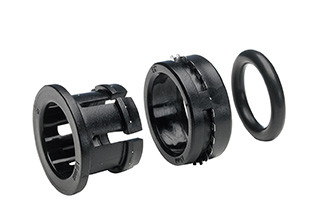Nov 21st 2023
Single O-Ring Seal vs. Double O-Ring Seal: Prioritizing O-Ring Material in Push-Connect Fittings
For fluid and air connections, push-connect fittings have gained popularity for their simplicity and efficiency. At the heart of these fittings lies the O-ring seal, a small yet crucial component for preventing leaks. A common discussion point surrounds the choice between a single O-ring seal and a double O-ring seal for added security. At Specialty Sales, we know that the correct choice of O-ring material for the application outweighs the number of seals. In this blog post, we'll explore the advantages of a single O-ring seal, highlight the potential overkill of a double O-ring seal, and underscore the paramount importance of selecting the right O-ring material.
Understanding the Basics of O-Ring Seals
Before delving into the debate, it's crucial to grasp the fundamental role of O-ring seals in push-connect fittings. These seals, made from rubbers like EPDM or nitrile, form a tight, leak-free connection when the fitting is engaged, ensuring the integrity of fluid and gas systems. They seal to the critical outer diameter of the inserted tubing.
The Single O-Ring Advantage
A well-designed and correctly chosen single O-ring seal is more than sufficient to maintain a reliable, leak-free connection. The simplicity of a single seal minimizes the chances of misalignment during installation, reducing potential points of failure. This simplicity translates to cost savings without compromising performance. At Specialty Sales, we carry the John Guest push-connect fittings, a proven manufacturer with millions of fittings successfully installed over the past 40 years – all with a single O-ring seal.
Overkill: The Double O-Ring Seal Conundrum
While the idea of redundancy might sound appealing, a double O-ring seal in push-connect fittings is overkill. The added cost and complexity of implementing two seals provide little tangible benefit. The practical advantages of a double O-ring seal become negligible compared to the simplicity and reliability of a single seal. From an economic standpoint, opting for a single O-ring seal makes financial sense. The cost of manufacturing, materials, and maintenance is lower when only one seal is involved. Moreover, troubleshooting and replacing a single O-ring is a straightforward process, reducing downtime and labor costs associated with maintenance. During installation, having a double O-ring seal makes it more difficult to insert the tubing, leaving the potential for a partially inserted install leading to a blow-out.
The Importance of O-Ring Material
Finally, amidst the single vs. double O-ring debate, it's crucial to highlight that using the correct O-ring material for the application is paramount. Different materials offer varying levels of resistance to chemicals, temperature, and pressure. Ensuring the compatibility of the O-ring material with the specific application is more crucial than the number of seals. For example, when John Guest fittings were first introduced to the United States market, only the gray acetal fittings with nitrile O-rings were available. Unfortunately, nitrile O-rings are susceptible to common household chemicals. So, when these fittings were installed under a sink next to cleaning chemicals, the presence of the chemicals would compromise the integrity of the O-ring and cause leaks. John Guest now offers polypropylene fittings with EPDM O-rings. We will always specify polypropylene fittings with EPDM O-rings for fluid (water) applications, leaving the acetal fittings with nitrile O-rings for air applications.
The Right Choice
In conclusion, the simplicity, cost-efficiency, and proven reliability of a single O-ring seal make it a practical choice for a wide range of scenarios. However, the ultimate key to success lies in selecting the right O-ring material that aligns with the demands of the application. The efficacy of the O-ring in maintaining a secure and leak-free connection hinges on its material compatibility with the fluid or gas system in question. Use the correct fitting and O-ring for the application, and you’ll only need one.
Contact Specialty Sales today to find the right O-ring for your application. You can call us at 800-323-3054 or contact us here.

